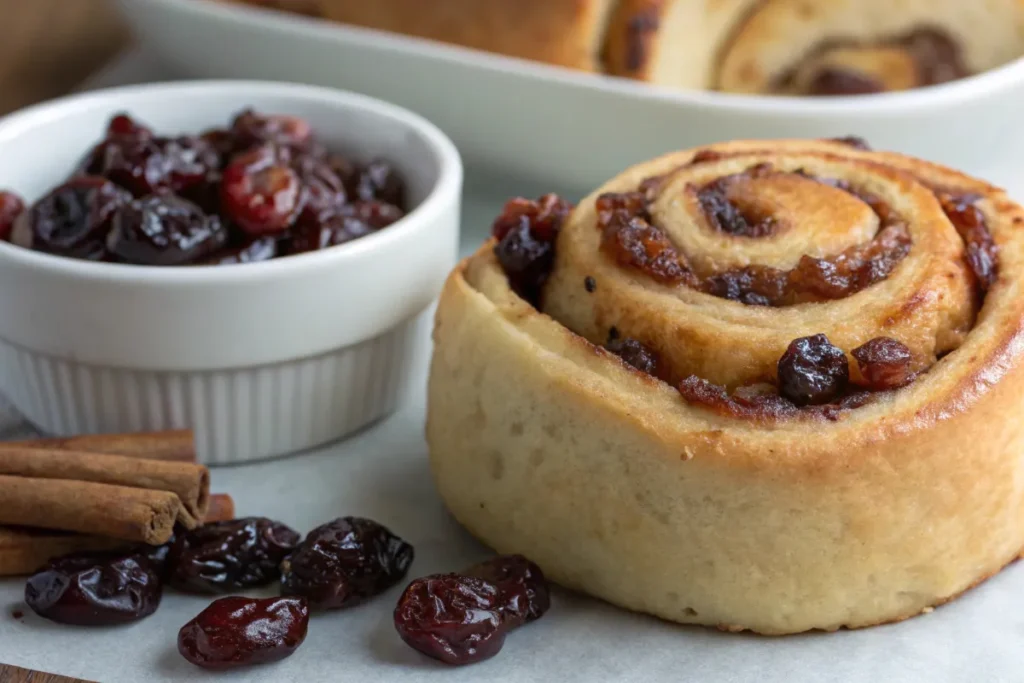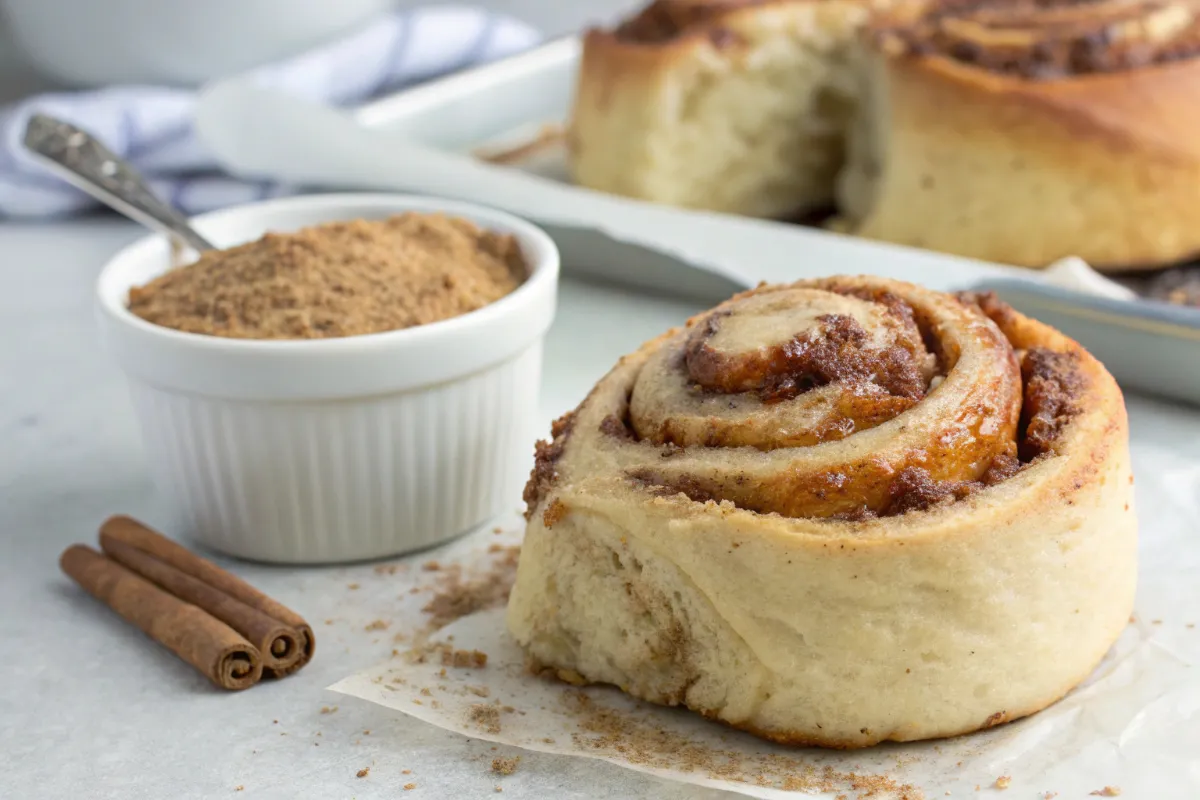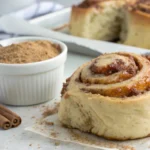When you think of cinnamon rolls, the first thing that comes to mind is likely the mouthwatering aroma of warm, spiced filling swirling inside soft, fluffy dough. But have you ever wondered, what is the filling for cinnamon rolls made of? The secret to a perfect cinnamon roll lies in this simple yet flavorful combination of ingredients. Whether you’re a seasoned baker or just starting, understanding the key components and mastering different variations of the filling will help you create the ultimate treat.
In this guide, we’ll dive deep into the essential ingredients, explore variations, and provide expert tips to help you perfect the art of making cinnamon roll filling. Let’s get started!
Table of Contents
Key Ingredients in Cinnamon Roll Filling

The filling may seem simple, but the balance of its core ingredients is crucial to achieving that gooey, indulgent flavor that everyone loves. When asking, “What is the filling for cinnamon rolls made of?” the answer is a combination of butter, sugar, and cinnamon, but there’s more to consider for achieving the perfect texture and taste.
1. Butter
Butter is the backbone of any good cinnamon roll filling. If you’ve ever wondered, “What is the filling for cinnamon rolls made of?” butter plays a key role. It not only adds richness and flavor but also helps bind the sugar and cinnamon, ensuring that the filling spreads evenly and melts into the dough as it bakes. Always opt for real unsalted butter over margarine. Margarine lacks the richness of butter and can result in a less flavorful filling.
Pro Tip: Make sure the butter is softened to room temperature. This allows for easy mixing and even distribution. Using softened butter, rather than melted, ensures the filling stays where it’s supposed to be instead of leaking out during baking.
2. Sugar: Brown Sugar vs. White Sugar
Sugar is what gives cinnamon rolls their delicious sweetness. Another important aspect when asking, “What is the filling for cinnamon rolls made of?” is the type of sugar used. While both brown sugar and white sugar can be used, they provide slightly different results:
- Brown Sugar: The molasses in brown sugar adds depth to the filling’s flavor and creates a gooey texture when caramelized. This is the traditional choice for cinnamon rolls and is ideal for those who prefer a richer, more indulgent flavor.
- White Sugar: If you prefer a lighter, less intense sweetness, white sugar can be used. However, it won’t create the same moist, caramelized effect as brown sugar.
3. Cinnamon
Cinnamon is what gives cinnamon rolls their signature taste, but did you know that not all cinnamon is the same? If you’re still wondering, “What is the filling for cinnamon rolls made of?” cinnamon is the key ingredient that defines the flavor. There are two main types of cinnamon, each offering a different flavor profile:
- Ceylon Cinnamon (true cinnamon): Known for its delicate, sweet flavor, Ceylon cinnamon is often considered the superior choice for baked goods. It’s less spicy and has a more refined taste.
- Cassia Cinnamon: This is the more commonly available cinnamon, which has a stronger, spicier flavor. If you prefer bold cinnamon rolls, this might be the better option for you.
4. Salt and Optional Spices
A pinch of salt is essential for balancing the sweetness of the filling. If you’re exploring different variations of “What is the filling for cinnamon rolls made of?” consider adding other spices. Even though the filling is primarily sweet, salt enhances the overall flavor and prevents it from becoming overly sugary. You can also experiment with other spices to create a more complex flavor profile:
- Nutmeg: Adds a warm, nutty undertone.
- Cloves: Provides a slightly sweet, aromatic kick.
- Cardamom: A unique spice that adds a hint of citrus and floral notes, elevating the traditional cinnamon roll filling.
When experimenting with variations in cinnamon roll recipes, like those found in How to Make Cinnamon Roll Pancakes, you’ll notice that the quality of butter greatly influences the final flavor and texture.
Creative Variations of Cinnamon Roll Filling

While the classic combination of butter, sugar, and cinnamon is beloved by all, there are countless ways to customize your cinnamon rolls. Understanding What is the filling for cinnamon rolls made of allows you to experiment with different ingredients to add richness, texture, or a fruity twist. These variations will inspire you to get creative and make your cinnamon rolls even more delicious.
1. Cream Cheese Filling
For a more decadent filling, try adding cream cheese to the mix. This tangy addition creates a delightful contrast to the sweetness of the cinnamon and sugar.
- How to Make It: Soften cream cheese to room temperature, then blend it with the butter before mixing in the sugar and spices.
2. Nutty Additions
Nuts bring both texture and flavor to your cinnamon rolls. Whether you choose pecans, walnuts, or almonds, the nuts toast while the rolls bake, adding a delicious crunch to the soft dough.
- How to Incorporate: Sprinkle chopped nuts evenly over the cinnamon-sugar filling before rolling up the dough.
3. Fruit-Infused Fillings
If you’re looking to add a fruity twist, consider incorporating dried fruits or fresh fruits like raisins or apples. These ingredients introduce a sweet, chewy element that pairs beautifully with the spiced filling.
- How to Use: If using dried fruits, soak them in warm water or juice for about 10 minutes to plump them up before adding them to the filling. Fresh fruits like apples can be chopped into small pieces and mixed with the filling.
For more information on the benefits of adding nuts to your baked goods, check out Nut Uses in Baking.
Step-by-Step Guide: How to Prepare the Perfect Cinnamon Roll Filling
The filling is the heart of a cinnamon roll, and its success lies in mastering the technique. Here’s how to make it like a pro:
Ingredients:
- ½ cup softened butter
- ½ cup brown sugar
- 2 tablespoons ground cinnamon
- A pinch of salt
Instructions:
- Gather Ingredients: Ensure that the butter is softened to room temperature for easy mixing. Avoid using melted butter, as this will result in a runny filling that doesn’t stick to the dough.
- Mix the Ingredients: In a mixing bowl, combine the softened butter, brown sugar, cinnamon, and salt. Use a spatula to blend the ingredients until smooth and evenly combined.
- Spread Evenly: Once the filling is mixed, spread it evenly across the rolled-out dough. Be careful not to overfill, as too much filling can cause leakage during baking.
- Roll and Seal: Starting from one end, carefully roll the dough into a tight spiral. Pinch the edges to seal the roll, preventing the filling from spilling out during baking.
- Bake and Enjoy: Bake according to your cinnamon roll recipe, and enjoy the aroma of freshly baked rolls filling your kitchen.
If you love delicious baked goods, you might also enjoy this Ham and Cheese Croissant Bake, a savory twist perfect for breakfast or brunch!
Common Mistakes to Avoid
Even the most experienced bakers can make mistakes when preparing cinnamon roll filling. If you’ve ever wondered, “What is the filling for cinnamon rolls made of?” it’s important to know that the right balance of ingredients can make or break your recipe. Here are some of the most common pitfalls and how to avoid them:
Using Melted Butter – Makes the filling runny and uneven. Use softened butter for a thick, spreadable texture.
Overfilling – Too much filling leaks out. Stick to the recommended amount for balanced rolls.
Skipping Salt – A pinch enhances flavor; without it, the filling may taste overly sweet and flat.
What is the filling for cinnamon rolls made of? The filling is truly the heart of any great cinnamon roll, transforming simple dough into a gooey, indulgent treat. By understanding what the filling for cinnamon rolls is made of and mastering the balance of ingredients like butter, sugar, and cinnamon, you can elevate your cinnamon rolls to new levels of deliciousness. Whether you stick with the classic filling or explore more creative variations like cream cheese, nuts, or fruits, the possibilities are endless.
With the right techniques and tips, you’ll be able to create cinnamon rolls that are soft, flavorful, and utterly irresistible. Happy baking!
FAQs: About What is the filling for cinnamon rolls made of
1. Can I Use Margarine Instead of Butter?
- While you can use margarine, it’s not recommended. Margarine lacks the richness and flavor that butter provides, resulting in a less flavorful filling.
2. What Type of Sugar Should I Use?
- Brown sugar is ideal for cinnamon roll filling because it adds depth and moisture to the rolls. However, if you prefer a lighter flavor, you can substitute with white sugar, though it won’t provide the same gooey texture.
3. Can I Prepare the Filling in Advance?
- Yes! You can make the filling ahead of time and store it in the refrigerator for up to two weeks. Just be sure to let it soften before spreading it on the dough.
4. How Do I Prevent My Filling from Leaking Out?
- To avoid leaks, use softened butter (not melted), don’t overfill the dough, and make sure to roll the dough tightly while sealing the edges well.
Cinnamon Rolls Filling
This Cinnamon Roll Filling is a rich, buttery, and perfectly spiced mixture that makes your homemade cinnamon rolls irresistibly gooey and flavorful. With just three simple ingredients, you can create the ultimate filling for soft, delicious rolls!
Ingredients
For the Cinnamon Roll Filling:
- ½ cup unsalted butter, softened
- ¾ cup brown sugar, packed
- 2 tbsp ground cinnamon
Instructions
-
Mix the Ingredients:
- In a small bowl, combine softened butter, brown sugar, and cinnamon.
- Stir until smooth and well mixed.
-
Spread the Filling:
- Roll out your cinnamon roll dough into a rectangle.
- Evenly spread the cinnamon-sugar mixture over the dough, leaving a small border.
-
Roll & Bake:
- Tightly roll up the dough, slice, and bake as directed.
Notes
- For extra richness, add 1 tsp vanilla extract or a pinch of nutmeg.
- For a gooier filling, mix in 2 tbsp heavy cream before spreading.
- For a crunchier texture, add ¼ cup chopped pecans or walnuts.



2 thoughts on “What Is the Filling for Cinnamon Rolls Made Of?”